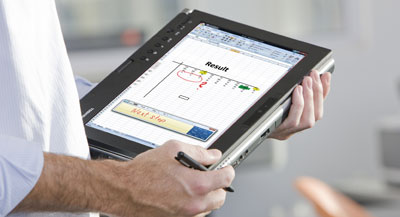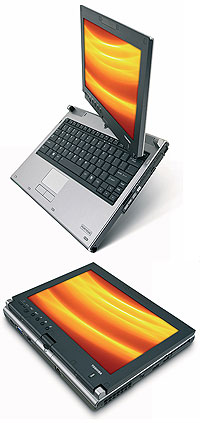|
Toshiba Portege M780
Toshiba's Tablet PC convertible gets an upgrade and switches to Intel Core i3/i5/i7 processors
(by Conrad H. Blickenstorfer)
In February of 2010, Toshiba introduced the Portege M780, the latest version of their Tablet PC convertible. It is a conventional convertible Tablet PC, i.e. a laptop with a display that can be rotated and laid down flat with the LCD side up so that the computer can be used as a tablet as well as a standard notebook. Essentially, the Portege M780 is an updated Portege M750, which was an updated M700, with each generation offering more and costing less. So, not much in terms of innovation, but a whole lot in terms of quality, experience, performance and value.

Pen computing historians know that Toshiba has a long history in slates and tablet computers, going all the way back to the early 1990s when the company introduced pen tablets and borrowed the name "Dynabook" for them. That term, of course, had initially been coined by Alan Kay who conceived the Dynabook as a "dynamic medium for creative thought," capable of synthesizing all media - pictures, animation, sound, and text - through the intimacy and responsiveness of the personal computer. In the early and mid-1990s, Toshiba sold its Dynabook T100 and T200 pen tablets. In 2002, Toshiba offered the first 12.1-inch Tablet PC convertible (the Portege 3500), and to this day Toshiba uses the Dynabook name for its notebooks in Japan (go see dynabook.com).
 As of early 2010, the Portege M780, together with its still-sold Portege M750 predecessor, is for now the last remaining pen product in Toshiba's lineup, here or anywhere else. As of early 2010, the Portege M780, together with its still-sold Portege M750 predecessor, is for now the last remaining pen product in Toshiba's lineup, here or anywhere else.
On the technology side, the most notable change is a switch from the M750's Core 2 Duo processors to the new Intel Core i3/i5/i7 chips and their complementing circuitry that includes the new Mobile Intel QM57 Express chipset. Note that -- in line with Intel's designation of the i3/i5/i7 processors as their "good," "better," and "best" processors -- Toshiba offers the starter version of the M780 (US$1,279) with a i3 chip, the mid-range version (US$1,499) with an i5 chip, and the top version (starting at US$1,799) with an i7 processor.
Disk speeds and sizes have gone up a bit and now start with a 5400rpm 160GB drive and range up to a 7200rpm 320GB drive, and there's an optional 128GB solid state drive. In most versions, the internal UltraSlim Bay includes a Super-Multi double layer optical drive.
The display still measures 12.1 inches diagonally. While some older Toshiba Tablet PCs (like the Portege M200 or Tecra M4) offered a high resolution SXGA+ (1400 x 1050 pixel) version, the only display available with the M780 is a WXGA (1280 x 800 pixel) LCD with LED backlight that is also available in indoor/outdoor viewable version with anti-glare treatment. Like its predecessors, the M780 can be had with both an active digitizer and a touch screen. Switching between the two is automatic. It's not clear whether the display supports multi-touch; Toshiba simply states that the display "fully exploits the capabilities of Windows 7; with Windows touch gestures it encourages workers to let their creativity run free."
The M780 remains a very functional, albeit not very exciting, machine. It is a notebook convertible that can be used as a standard laptop, as a slate, or anything inbetween. The M780 measures 12 x 9.4 x 1.5 inches and weighs about 4.65 pounds, a bit more than its predecessors and perhaps a bit hefty for a machine in this class. There are some basic ruggedness provisions like a spill-resistant keyboard and the European specs suggest the ability to survive a 3.3-foot drop, but Toshiba's website and literature does not provide other environmental specs.
On the connectivity side, you get IEEE1394 Firewire and two USB 2.0 ports as well as an eSata/USB combo port, a multi-format card reader (SD, SDHC, Mini SD, Micro SD, Memory Stick, Memory Stick PRO, MM Card, XD-Picture Card), modem, gigabit LAN, audio in/out, microphone, port replicator, and an ExpressCard slot that replaces the PC Card slot on the older versions. There's also an optional vidcam for videoconferencing. For security there's a fingerprint reader and TPM 1.2, but no Smart Card reader.
With the Portege M780 Toshiba continues its course of offering tried-and-true rather than daring forward-looking tablet computer technology. There's nothing wrong with that, and it is mostly in line with what the competition has to offer. The new processors should offer nice performance increases, and we always appreciate an integrated optical drive.
|



